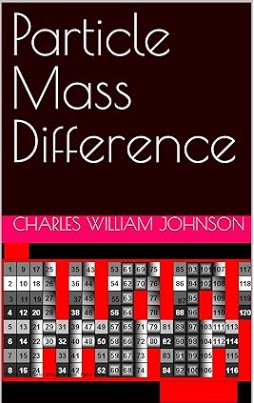
A Constant Factor for The Difference Between
the Proton Mass and the Neutron Mass:
2.3055E-30
New Orleans, LA.- 1 January 2005 - The differences in value between the constants hardly ever appear in the handbooks on physics and chemistry. The various physical and chemical constants are frequently presented as reciprocals. For example, the ratio between the proton mass and the neutron mass (1.001378374) is often cited as a main physical constant.
| Neutron Mass / Proton Mass = Ratio Mm : Mp 1.6749286 / 1.6726231 = 1.001378374 |
It is difficult, if not impossible, to find any significant analyses of the differences among the many physical and chemical constants. Consider the difference between the proton and neutron masses: 1.6749286 - 1.6726231 = .0023055. Logically enough, if the distinct atomic and sub-atomic particles exist and behave as of distinct quanta, or packets of energy, then it is reasonable to consider the idea that the differences among the cited quanta are equally significant. In our analyses of the Earth/matriX temperature scales, the difference of 2.3055c fractal between the mass of a proton and the mass of a neutron reveals just such a significance.
The difference factor reveals its significance for particle mass in the next step, when we divide the neutron and proton masses by the factor 2.3055c.
|
1.6749286E-27
/ 2.3055E-30 = 726.4925613 Neutron mass
|
|
1.6726231E-27
/ 2.3055E-30 = 725.4925613 Proton mass
|
Surprisingly enough, the numbers that result are nearly the same value, differing only by one digit, the third digit of each term.
|
The
Difference 726.4925613 - 725.4925613 = 1.0
|
The 2.3055c difference factor appears to act as a common denominator, thereby producing a system of numerical values based on the unit one for the differences between the neutron mass and the proton mass. The difference factor is relevant for many other physical and chemical constants.
| Atomic Mass Constant 1.6605655E-27 / 2.3055 = 720.26263 | |
| 1 / 720.26263 = .0013883824 | |
|
.0013883824 / 2.3055 = 6.0220449
Avogadro Constant
|
|
View the complete analysis of the difference constant for particle mass and other related Earth/matriX essays on the web-site www.earthmatrix.com/schemata/
PARTICLE MASS DIFFERENCE The book Particle Mass Difference was published in 2004, where I presented the idea of the difference between the proton and the neutron as a concept of measurement. In this book, I explain in detail the reasoning behind the concept of "differences" in ancient reckoning and in physics and chemistry.
Most of the CODATA constants are given with reference to the constants and their ratios, and to a lesser degree as moments and anomalies. One does not find a list of the "differences" between any of the constants. The only difference that appears is that referred to as mass defect (2.388c fractal), whereby the sum of the masses in the nucleon is distinct to their individual masses. In 2013, the constant of the proton-neutron difference (2.3055c fractal) entered some of the handbooks on physics and chemistry.
|
Contact Information:
Earth/matriX: SCIENCE TODAY
www.earthmatrix.com
Contact:
Charles William Johnson e-mail:
johnson@earthmatrix.com
©January 2005-2014 Copyrighted by Charles William Johnson. All rights reserved.
| Home | Links | Author |

